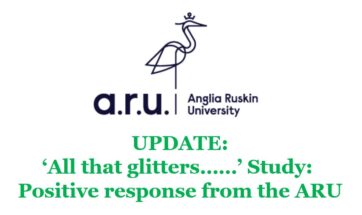
Ronald Britton’s observations relating to the ARU’s ‘All that glitters is litter?…’ study.
Ronald Britton Ltd.’s observations following articles in the BBC and Guardian on the 15th October 2020 and by Cosmetics Business on the 22nd Oct 2020 relating to the ARU Study ‘All that glitters is litter?…’
We have read with interest the findings of the Applied Ecology Research Group (Anglia Ruskin University, Cambridge) in the scientific paper ‘All that glitters is litter? Ecological impacts of conventional versus biodegradable glitter in a freshwater habitat’. This paper was the basis for the media reports issued around mid October 2020.
Beware Media Sensationalisation: After reading both the media reports and the study it is interesting to observe that the media reports tend to highlight only certain aspects of the study, while overlooking others. Below are our observations relating to the actual study.
Summary Observations
- The manufacturer and source of the ‘biodegradable glitter’ tested is unknown.
- We sought clarity from the authors of the study to discuss this and other fundamental issues we had with the methodology. We had no response.
- No product codes, batch numbers or other id is provided to link the product tested in the study to any manufacturer.
- The number of manufacturers supplying ‘biodegradable glitter’ to the UK market runs well into double figures.
- 2018 study: The study was conducted in July 2018 and published at the end of 2020.
- From Bioglitter’s point of view, 2018 is an age ago. Click here to view our development timeline. We now offer 7 ranges, 6 of which are TÜV Austria OK biodegradable WATER certified (fresh water biodegradable certification). To our knowledge no other glitter manufacturer has any certification, not even at a composting level which is far inferior biodegradability performance compared to that required in fresh water
- Claims made about how ‘eco-glitters’ are tested don’t apply to Bioglitter™:
- The study claims that only the core of ‘eco-glitters’ are tested for biodegradability and that the biodegradability of coatings, as well as ecotoxicity of the glitter are ignored.
- This is not the case with genuine Bioglitter™ products. Testing and certification take into account the whole product and its ecotoxicity. It’s now been acknowledged by the authors of the news reports that genuine Bioglitter™ is tested as a whole finished product.
- Overdosing of test environments: From data in the report it appears the test environments are significantly overdosed, upwards of 1000 times greater than might reasonably be expected in terms of glitter as a proportion of all microplastic pollution.
- The study control test environment had nothing added, whereas the other test environments had material added. Therefore, the control does not isolate the effect of adding an additional material i.e. foreign bodies (inert or other) to the test environment.
- Even the inorganic, non-biodegradable products tested, i.e. the natural mica and synthetic mica (mineral material) are shown to have an impact on the test environment. This suggests that overloading a micro test environment with anything could have some sort of effect.
- Pile enough sand on a lawn and it will have an effect on the grass beneath.
- New Zealand mud snails were purposely added: – Only this one species of snail was present in the study. The study reported that the number of snails increased rather than decreased in the environment that contained the ‘biodegradable glitter’
- Snails are known to consume biodegradable material.
- The study does not take into account that a product like Bioglitter™ biodegrades in natural, fresh water environments and is independently proven not to persist and therefore will not build up over time. Ronald Britton is the world’s only glitter manufacturer to offer products that are certified ‘OK biodegradable WATER’ by TÜV Austria. A level of certification considered the highest of its kind in the world.
It is important to note that in the news stories ‘Eco glitter’ is used to describe both the non-biodegradable mineral-based mica and synthetic mica pigments tested, as well as biodegradable glitter. To reiterate, all the ‘Eco glitters’ tested are shown to have adverse effects in the study at the high dosage levels used, yet the impression is given that they are all ‘so called biodegradable’ glitters. This is not the case and suggests an unfair bias towards this one particular type of ‘Eco glitter’ in the reporting.
Detailed
The glitter dosage used in the study to assess its ecological impact we believe to be orders of magnitude higher (upwards of 1000 times higher) than can be reasonably expected to be found in the environment. The dosage level is based upon studies of total microplastic pollution in rivers, but does not take into account the proportion of which is glitter, nor does it take account the fact that a product like genuine Bioglitter™ will biodegrade and not accumulate in the same way as conventional plastic glitter or so called ‘eco glitters’ that do not biodegrade in fresh water environments. Our own worse case estimate is that conventional glitter represents approx. 0.05% of global microplastics pollution. On this basis the impact of glitter, if any, on the ecological parameters used in the 36 days study would likely be vastly reduced at significantly lower dosages. However, even at much reduced dosages, we recognise there is still a long-term risk to the environment posed by conventional PET based glitter.
The study also concludes that even 100% natural mica and 100% synthetic mica, both mineral products (eg stone), produced similar results in the tests to the glitters tested and had an effect on the test environment. Micas are also known as pearlescent pigments, are ubiquitous in use, and produce shimmer effects. They are a completely different type of effect pigment compared with traditional glitters. The results in the study are certainly surprising considering micas are inorganic mineral-based pigments and may suggest that heavily overloading a micro test environment, even with an inorganic mineral material will have some sort of effect.
In response to the environmental problems associated with glitter, British company Ronald Britton Ltd has been on a journey of continuous development of its cellulose based Bioglitter™ product ranges. Ronald Britton is the world’s only glitter manufacturer to already offer products that are certified ‘OK biodegradable WATER’ by TÜV Austria. This certification demonstrates that these products quickly biodegrade in natural freshwater environments, such as rivers and lakes. This is the highest level of independent certification for freshwater biodegradability in the world. https://www.tuv-at.be/green-marks/certifications/ok-biodegradable/
In the ‘All that glitters……………’ paper, it is stated that ‘only the core material of glitter needs to be tested in order to be certified as biodegradable.’ This is inaccurate and not the case with Bioglitter™. All testing and eventual certification of genuine Bioglitter™ products is based on the finished product and takes into account the biodegradability and environmental impact of both the regenerated cellulose core material and the coatings used to impart sparkle and colour.
Products made with Ronald Britton’s Bioglitter™ display our registered Bioglitter™ trade mark to enable consumers to easily identify and ensure it is genuine Bioglitter™ and not one of the many unqualified ‘eco glitters’ that are freely available on the market.
Ronald Britton Ltd remains committed to delivering sparkle with minimal environmental impact.
Andrew Thompson (Technical Director) & Stephen Cotton (Commercial Director)
